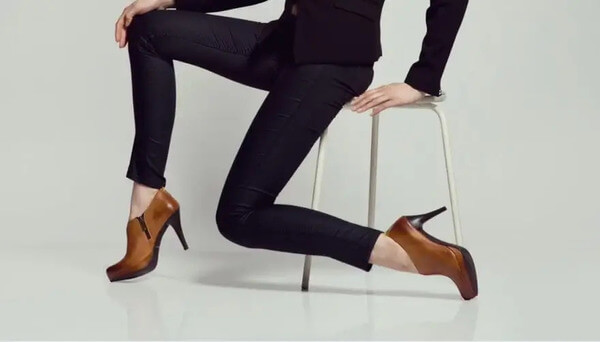Author: Randeep Singh / go to all articles on Yoga Concepts

High heeled foot ware makes
a woman’s legs look more shapely,
but it has its own repercussions
on the health.
Feet which remain squeezed into
high heels for years together,
experience pain and related,
sometimes serious, foot ailments.
Foot ailments due to high heels
of course make walking difficult, as alignment of the feet with respect to the body gets disturbed, the issues which emerge due to high heel walking can sometimes call for surgery, such can be the health risks of high heels.
Health risks of High heels – Anatomically incorrect
The high heels and pointy toes of high heeled shoes spell double trouble. By elevating the heel they shift most of the woman’s weight on to the front of the foot. (while standing with correct posture – barefoot – the heel shares the load), the shift in weight increases pressure on the balls of the feet. For each inch of heel height, the pressure on the ball of the foot increases about 25 percent. A three Inch heel, for instance puts 75 percent more pressure on the ball of the foot than going barefoot.
The possible consequences of all this forefoot pressure included calluses, or build ups of hard, thickened skin on the ball of the foot; hammertoes, blisters, and a painful inflammation of the nerve between the third and the fourth toes, known as a Morton’s neuroma. High heels can also lead to Achilles tendinitis, a soreness in the chord that attaches the calf muscles to the heel bone. This condition occurs as heel elevation, overtime, causes the lower calf to shorten and tighten. Wearing flats or going barefoot then strains the tendon.
Many women resort to surgery to correct the pain and deformities caused by shoes. However, a much simpler solution often may be by merely modifying the high heel habit.
- Reserve high heels for special occasions. For work, wear walking or jogging shoes when you can; slip on the more fashionable shoes only when necessary and kick them off whenever possible.
- To prevent Achilles tendinitis stretch your calf muscle regularly.
- Get the shoe repair shop to put the extra foam cushioning in the forefoot of new shoes to prevent calluses on the balls of the feet – but only if the toe is deep enough to accommodate a cushion comfortably.
- Buy Properly fitting shoes.
How to select comfortable shoes?
- Have your feet measured regularly. With age, feet tend to grow wider and longer.
- Have booth feet measured. If one foot is larger than the other, fit the shoes to the larger foot.
- Make sure the shoe is wide enough to fit the largest part of your foot. Because foot usually widens as you stand, stand up during the fitting.
- Make sure you can wiggle all your toes. The longest toe should have a 3/8 inch to 1/2 inch space at the end of the shoe.
- Don’t expect the shoe to stretch to fit. Shoes shouldn’t have to be “broken in.”
- Choose a shoe with a soft leather upper. It will conform to the shape of the foot and allow the foot to breathe.
- Try to avoid heels higher than 1 inch.
- Walk in the shoe to make sure it fits and feels good. As to walk on a hard surface rather than a carpet in the store.
- Try on shoes at the end of the day, when the feet tend to be a bit swollen.
Treat your Feet
To soothe tired, aching feet use these three methods.
Elevate: Elevating the feet reduces swelling, often caused by circulatory problems.
Soak: A warm water bath is a great way to relax and increase circulation to the feet. One method is to sit on the edge of the bath tub and allow running water to embrace your feet. Or soak your feet in lukewarm water, with or without Epsom salts, for at least 15 minutes.
For a dry soak, ‘ wrap your feet first in a dry towel and then in hot, moist towels. Elevate your legs and luxuriate in a 15-minute rest.
Massage: Nothing beats a massage for relieving tired, swollen feet. A massage stimulates circulation and relaxes overworked muscles. It also offers a time for examining the foot for developing corns, calluses, and other problems.
Start by warming your feet with a soak. Then sit with one leg crossed over the other, with the sole of the feet facing you. Apply moisturizer to your hands and move your thumbs in deep circular motions, concentrating on small areas at a time and working from your toes to your ankle. Using your thumbs, kneed the bottom of your foot, then stroke the top.
Gently squeeze your foot an move your thumbs away from one another to stretch the tendons. Pinch along the outside edges of the foot. Finally, tug on each toe and wiggle it. Repeat the process with the other foot.
Read other Informative Articles….
